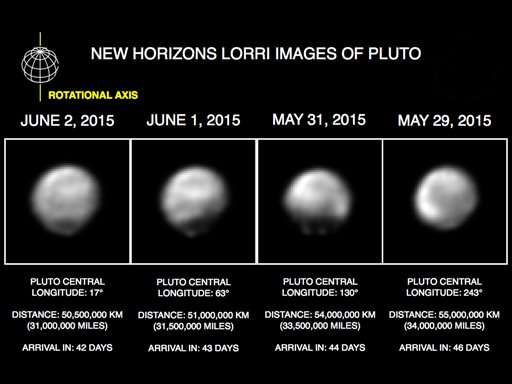This image made available by NASA/Johns Hopkins University Applied Physics Laboratory/Southwest Research Institute on June 11, 2015 shows four computer-enhanced views of Pluto, taken by New Horizons' Long Range Reconnaissance Imager (LORRI). On July 14, 2015 New Horizons is expected make its closest approach to Pluto. The spacecraft will fly within 7,750 miles - the approximate distance between Seattle and Sydney. It will be the first spacecraft to explore the tiny, icy world once considered a full-fledged planet. (NASA/Johns Hopkins University Applied Physics Laboratory/Southwest Research Institute via AP)
NASA's New Horizons spacecraft is at Pluto's doorstep, following an incredible journey of nine years and 3 billion miles.
Four weeks from Tuesday—on July 14—New Horizons will make its closest approach to Pluto. The spacecraft will fly within 7,750 miles, inside the orbits of Pluto's five known moons. That's the approximate distance between Seattle and Sydney.
It will be the first spacecraft to explore the tiny, icy world once considered a full-fledged planet.
As of Tuesday, New Horizons was just over 20 million miles from Pluto. That's closer than Earth is to neighbor Venus, at their closest point. Flight controllers fired a thruster on the spacecraft over the weekend to fine-tune its path.
"This is one charged-up team," principal investigator Alan Stern of the Southwest Research Institute in Boulder, Colorado said last week. "They know that they're getting to do something very special because nothing like this has happened" since Voyager 2's flyby of Neptune in 1989. NASA's first interplanetary success was at Venus, with Mariner 2 in 1962.
Stern added: "We're going to turn a point of light into a planet and its moons overnight in the next month."
The Johns Hopkins University's Applied Physics Laboratory in Laurel, Maryland, is operating the spacecraft for NASA. The lab also designed and built the relatively lightweight craft, about the size of a baby grand piano. It carries seven science instruments; the cameras have been photographing the planet since January.
The latest pictures, taken at the end of May and beginning of June, show large dark regions toward the bottom of Pluto. Scientists are eager to learn the size and shape of these dark spots, as well as their exact location. Images will keep improving with every step closer to Pluto.
"It's very fascinating to see this level of detail," deputy project scientist Cathy Olkin said during an update broadcast Tuesday.
Pluto was discovered by the late American astronomer Clyde Tombaugh in 1930. Its moons, the fifth unmasked as recently as 2012, also bear names related to the mythological underworld: big moon Charon and mini-moons Nix, Hydra, Kerberos and Styx.
More moons could be out there.
"We're going to write the textbook. We know very little about the Pluto system now," Stern said. "It's really a mission of raw exploration, flying into the unknown to see what's there."
New Horizons' $700 million mission began with a 2006 launch from Cape Canaveral, Florida.
More information: Johns Hopkins: pluto.jhuapl.edu/
© 2015 The Associated Press. All rights reserved.
























